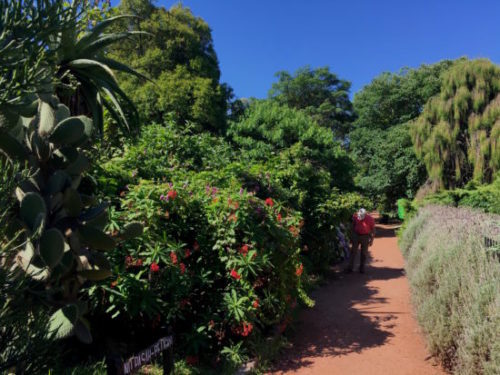
For a long time, Pennsylvania’s Longwood Gardens has been my go-to destination for the holidays. The magnificent property features over 1,077 acres of formal gardens, woodlands and meadows that change with each new season. Located at the heart of the gardens is one of my favorite places, the huge glass and steel Orangery. It is here, in this 1920’s-era greenhouse, that my holidays come alive in the horticultural extravaganza known as A Longwood Christmas.

When it comes to inspiring, it doesn’t get much better than Longwood Gardens. From late November to just after the New Year, the Orangery is filled with holiday-themed displays, including hundreds of decorated trees, rare plants and miles of seasonal flowers. Covering nearly four acres of greenhouses, the colorful blooms and exotic specimens are all embellished with millions of twinkling lights.
At my most recent visit, each turn of the corner revealed a new color scheme, plant display and fragrance; a heady combination that made for a constantly changing experience.

This year’s display showcases over 6,000 seasonal plants.
THE TOUR
To begin their tour of the Orangery, visitors enter through the majestic East Conservatory. In this huge, vaulted space the predominantly red, white and silver horticultural displays are punctuated by gurgling fountains and tiered pools all linked by rushing streams of water. A warm, earthy aroma mixed with flower fragrances permeates the space.

This year’s exhibit in the East Conservatory features formal flower beds and manicured pathways fringed by generous drifts of fragrant paper white narcissus, euphorbia ‘Diamond Frost’, miniature arborvitae, ferns and snow white cyclamen. A permanent display of giant palms and other tropical plants provides the backdrop for the seasonal flowers.

A number of beautiful Christmas trees are situated within the beds and along the walkways.


Close-up of some of the stunning detail on each of the trees.

At the end of the East Conservatory is the largest tree of the exhibit, an 18-foot Douglas fir. The giant tree is encircled by bright green ferns that point up the tree’s deep red ribbons and other natural decorations.

Behind the East Conservatory is the Main Conservatory exhibit. The dramatic space consists of a pair of manicured lawns encircled by seasonal plantings and massive stone columns wreathed in ivy. Giant hanging baskets of scarlet poinsettias are suspended high above the display.

Lawn in the Main Conservatory
On a bright winter day at Longwood Gardens, sunlight filters down through the vaulted iron and glass ceiling and traces a path across the lush borders of this iconic space.

I’ve always loved how, in the far corner of the Conservatory, the color palette shifts from traditional reds and greens to vibrant yellows and blues. This year’s exhibit includes a healthy dose of bright yellow twig dogwoods, orange birds of paradise, miniature lace-cap hydrangeas, soft pink poinsettias and spiky blue coleus.

Directly behind the East Conservatory is Longwood Gardens’ Exhibition Hall. Small jets of water spout from a sunken area in which ‘floats’ a grand central tree decorated in bright red poinsettias and snow white orchids.

The soft purple blooms of bougainvillea growing along the Conservatory’s rafters set up a strong color contrast with the bright red poinsettias.
After the brilliant colors of the main Conservatory, the minty green Acacia Passage provides a cool refuge. It is best known for the lacy tendrils of cinnamon wattle trees that travel up its walls and cascade down from the ceiling. Potted white hydrangeas underplanted with trailing ivy lead the eye down through the narrow space.

Located at the far end of the Acacia Passage, the Orchid Room (part of Longwood Gardens’ permanent display) features over 500 fragrant orchid varieties. An orchid grower replaces plants three times a week to ensure a continuous colorful exhibit.


Orchid vanda ‘Sansai Blue’ hangs in the Orchid Room
A right turn takes you to the Mediterranean Garden, which showcases plants from regions around the world with Mediterranean-like climates. The central tree is decorated in bright-colored balls that echo the warm-climate plantings.


Kniphofia uvaria, commonly known as Red Hot Poker
In the Bonsai Hall, a dramatic red and green wreath hangs in stark relief against the pale grey wall.

At the far end of the Mediterranean Garden is the Palm House, which is designed to resemble a tropical rain forest. The three-layered garden showcases Longwood Gardens’ wide variety of palms, cycads and tropical groundcovers. This tropical tree displays Aglaonema ‘Osaka’ (a variety of Chinese evergreen) on a custom-made form topped with flower heads pulled from Longwood’s palm collection.


Close-up of the Palm House tree
One of the most dramatic trees of all is housed in the Xeriscape garden, a stunning mix of grey, white, silver and red drought-tolerant plants.


Close-up of the succulent tree
At Longwood Gardens, even the mini pitcher plants are decorated for the holidays.

For more information on the exhibit, go to A Longwood Christmas. The display is open from now until early January.







































































